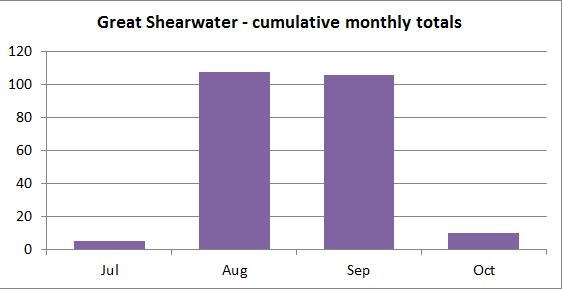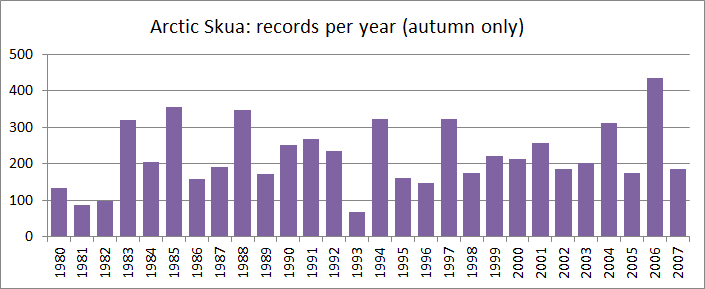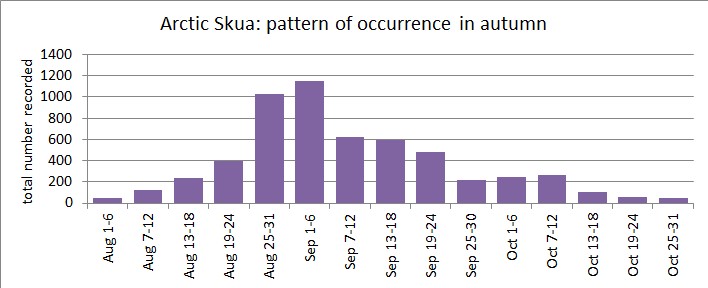Meadow Pipit - 1894
 Friday, December 17, 2010 at 10:56PM
Friday, December 17, 2010 at 10:56PM Species account from M Mathew, 1894, "The Birds of Pembrokeshire and its islands"
 Mathew,
Mathew,  passerine,
passerine,  pipit in
pipit in  Meadow Pipit
Meadow Pipit  Friday, December 17, 2010 at 10:56PM
Friday, December 17, 2010 at 10:56PM Species account from M Mathew, 1894, "The Birds of Pembrokeshire and its islands"
 Friday, December 17, 2010 at 10:53PM
Friday, December 17, 2010 at 10:53PM Species account from M Mathew, 1894, "The Birds of Pembrokeshire and its islands"
 Friday, December 17, 2010 at 10:41PM
Friday, December 17, 2010 at 10:41PM Puffinus gravis
Further offshore observations from boats could throw further light on the pattern of occurrence of this species, as in some years few, or none, might pass through the Irish Sea. Using the data so far available, 85 % more birds were seen offshore than from the land on dates when weather permitted hire vessels to go to sea and simultaneous observations could be made from land.
The largest numbers seen from land have mostly been when strong onshore winds have prevented offshore observations. The county day maximum of 25 was recorded passing Strumble Head on the 31st August 2002 when the sea was too rough for small craft to put out to sea. It is possible that observation from a large vessel offshore that day might have revealed a greater presence than has so far been indicated. Resolving such observational incompatibilities presents a challenge.
Graham Rees
(Covers records up to and including 2007)
 Friday, December 17, 2010 at 10:39PM
Friday, December 17, 2010 at 10:39PM Puffinus gravis
The majority, 128 birds, were seen from Strumble Head, a further 8 from the islands of Skokholm, Skomer, Ramsey and South Bishop combined.
For a species known to mainly travel well offshore it might be expected that the majority passing through the Irish Sea would be out of sight from land. Opportunities to detect these have been limited by the cost and availability of suitable boats and rough weather sometimes limiting their use. Despite these restrictions a total of 93 birds have been logged in the offshore waters of Pembrokeshire.
A group of 23 were flushed by the passing Fishguard to Rosslare ferry on the 15th September 1981. Five sightings of single birds were made from the Smalls during the autumn of 1982 – 84 when there were daily observations from the lighthouse. One was seen south of Caldey on the 4th August 1991 from the Cork to Swansea ferry. Three were seen from the Fishguard to Rosslare ferry on the 10th September 1999. Two were logged about 10 miles north of the Smalls on the 8th September 2006 from a ship on passage from the USA to Liverpool.
A total of 59 were encountered between 1998 and 2002 from shark–fishing vessels hired to visit the Celtic Deep area.
The largest incursions into our waters were in 1999 when a total of 41 was logged in the Celtic Deep compared to 11 inshore off Strumble Head and in 2002 when 17 were seen in the Celtic Deep and 29 recorded at Strumble Head.
 Friday, December 17, 2010 at 10:26PM
Friday, December 17, 2010 at 10:26PM Puffinus gravis
Near annual passage migrant.
The Great Shearwater breeds on islands in the Tristan da Cunha group, Gough Island and Kidney Island in the Falklands. Outside the breeding season they migrate up the western Atlantic to Newfoundland, spreading to Greenland and the Denmark Strait. They return southwards on the eastern side of the Atlantic, passing between July and November. They normally travel well offshore but onshore winds push a proportion close to the coast of Western Europe.
The first one recorded in Pembrokeshire was on the 15th August 1957, when C. M. Swaine watched it passing through Jack Sound, the channel between Middleholm and the mainland. Between 1973, when it was next recorded, and 2007 a total of 228 birds were logged. All were between July and October, the earliest one off South Bishop on 14th July 1975, the latest off Skomer on 29th October 1994.

 Friday, December 17, 2010 at 10:14PM
Friday, December 17, 2010 at 10:14PM Lullula arborea
Former breeding resident, now a scarce visitor.
The breeding range of the Woodlark is largely confined to Europe, stretching from North Africa in the south to southern Scandinavia in the north and from Iberia in the west to the Urals in the east.
When assessing the Woodlark’s status in Pembrokeshire in 1894, Murray Mathew considered it to be resident but scarce and local, although formerly “very generally distributed and a constant resident”. He attributed this change to the activities of bird catchers, who could realise 36 shillings per dozen for them, apparently a premium price. Mathew feared the Woodlark’s “obliteration from our county list.”
Writing in his diary in 1927 Bertram Lloyd (1939) stated “This bird is quite common in the central part of Pembrokeshire and is spread right across the county wherever the ground is suitable.” He went on to note their decrease following the severe winter of 1928/29, with a subsequent recovery in the years up to 1937, the year of his last available diary.
The next appraisal was in 1947 when Ronald Lockley concluded that Woodlarks were widely distributed throughout the county, being most numerous in the east and north–east and considered them to be as plentiful around the foothills of the Mynydd Preseli as anywhere else in Britain.
The Pembrokeshire Woodlark population crashed following the arctic winters of 1961/62 and 1962/63. The last known breeding in the county was at Amroth in 1965 although five seen about Brynberian Moor in May 1967 was suggestive.
Thereafter each individual sighting was recorded, the species having become so scarce. Two were noted in 1968 and one in 1971. Observer cover increased from the 1980’s resulting in the following detection rate:
Number of birds recorded per year.

Of these 20 were in the autumn, October – November, nine in winter, December – February, four in spring, March – early May. None were seen in other months and none in potential breeding habitat during the breeding season. All records were from coastal or near coastal localities.
Woodlark numbers have increased in southern England, in round figures from 250 pairs in 1986, through 600 pairs in 1993 to 1,500 pairs by 1997. More recently they have nested in Gwent, raising the hope that they may eventually return to Pembrokeshire as a breeding bird, perhaps as a result of climate change aiding their survival.
Graham Rees.
(Covers records up to and including 2008).
References
LLOYD. B. 1929-1939 Diaries, National Museum of Wales.
LOCKLEY. R. M, INGRAM. C. S. and SALMON. H. M.1949. The birds of Pembrokeshire, West Wales Field Society.
MATHEW. M. 1894. The birds of Pembrokeshire and its islands, R. H. Porter
 Saturday, November 27, 2010 at 10:13AM
Saturday, November 27, 2010 at 10:13AM Stercorarius parasiticus
Age and or morph was recorded for the bulk of the Arctic Skuas seen at Strumble Head between 1980 and 2006. Adults made up 67 % of the total, of which 31 % were light–phase, 33 % dark–phase and 3 % classified as intermediates, the remaining 33 % of the total were predominantly juveniles, though some first and second year birds were identified.
Graham Rees.
(Covers records up to and including 2007).
 GHR,
GHR,  Skua,
Skua,  seabird in
seabird in  Arctic Skua
Arctic Skua  Saturday, November 27, 2010 at 10:12AM
Saturday, November 27, 2010 at 10:12AM Stercorarius parasiticus
The Arctic Skua has been sparse in Pembrokeshire waters during spring, with one to three per annum being the norm during the period 1958 to 2003, passing between the 4th April and the 30th June. Four in 1998, six in 1996, eight in 2002 and 10 in 1993 exceeded the norm. Records came from Tenby, Broad Haven (S), St Govan’s Head, West Blockhouse, St Ann’s Head, Skokholm, Skomer, The Smalls, St Bride’s Bay and Strumble Head.
Graham Rees.
(Covers records up to and including 2007).
 Saturday, November 27, 2010 at 10:10AM
Saturday, November 27, 2010 at 10:10AM Stercorarius parasiticus
The number of birds involved each autumn varied, extremes being 67 in 1993 and 355 in 1985. Differing breeding success no doubt played a part in this variability but changing weather systems seem to have been the main factor.
Autumn totals at Strumble Head, 1980 – 2007.

Passage has been recorded from July to December, at Strumble Head between 1980 and 2006, a total of 24 being seen in July, 32 in November and 5 in December. Totals for the months August to October, expressed in six day periods were:

Light to moderate winds with a westerly component prevailed in most autumns. It was thought that some of the Arctic Skuas travelling southwards through the Irish Sea were drifted eastwards into Cardigan Bay by these westerly winds. When the skuas encountered the north Pembrokeshire coast they followed it in a westerly direction, so as to gain sea room for their continued southward migration. When south–westerly gales occurred larger numbers appeared in Cardigan Bay, presumed to have been blown there from the sea area south of the Irish Sea. When the wind veered to between west and north before moderating, these birds were able to make their way back out to sea, many of them passing close in to Strumble Head. It was such a weather system that resulted in the largest day total recorded when 103 passed on the 3rd September 1983.
Light to moderate north–east winds predominated in the autumn of 1993 and few Arctic Skuas were seen, most of those that did pass were during short interludes of westerly winds. Strong winds from due east dominated the autumn of 2003 when a total of 203 Arctic Skuas was logged passing. Such winds could be expected to drift southward travelling birds away from Cardigan Bay, so it seems likely that those seen at Strumble Head had arrived by flying overland from the North Sea assisted by the following wind.
Observational evidence indicates that Arctic Skuas are diffusely spread once they have cleared the north coast of the county. Daily observations from The Smalls throughout the autumns of 1983 and 1984 recorded far fewer birds than passed Strumble Head on the same dates. Offshore watchers using boats going as far out as the Celtic Deep only occasionally encountered one or two Arctic Skuas, as was the case with shore based watchers on the west and south coasts of the county and on the offshore islands. At Skokholm the mean autumn total from 1953 to 2003 was seven birds.
Graham Rees.
(Covers records up to and including 2007).
 Saturday, November 27, 2010 at 10:09AM
Saturday, November 27, 2010 at 10:09AM Stercorarius parasiticus
Passage migrant.
The Arctic Skua has a circumpolar Arctic breeding distribution extending southwards to northern Scotland. Migrants seen passing through British waters are en route to and from Atlantic wintering areas, principally south of the equator.
Mathew (1894) noted just one record of an Arctic Skua, shot at Goodwick, but gave no date. Lockley et al (1949) considered it to be occasional off Skokholm and Grassholm, mainly in August and September but sometimes in May or June.
A mean of 10 per annum was recorded in the county between 1953 and 1975, during a period when little seawatching was conducted. The low detection rate being linked to a paucity of watching was emphasised when Saunders (1976) noted 45 passing Strumble Head on the 8th September 1974. Watching at this headland became more frequent from 1978, with regular autumn observations from 1980 onwards. The annual average total of Arctic Skuas recorded in Pembrokeshire between 1980 and 2003 rose to 235, 90 % of them being seen at Strumble Head, passage taking place between July and November, the majority between August and October.
Graham Rees.
(Covers records up to and including 2007).
 GHR,
GHR,  Skua,
Skua,  passage,
passage,  seabird in
seabird in  Arctic Skua
Arctic Skua  Tuesday, November 23, 2010 at 6:59PM
Tuesday, November 23, 2010 at 6:59PM Pandion haliaetus
Scarce passage migrant.
The Osprey has a worldwide breeding distribution, being absent only from the Polar regions. It is a summer visitor in temperate zones, north European birds wintering as far south as Africa.
The Osprey was formerly a rare bird in Pembrokeshire. Mathew (1894) knew of no occurrences but I. K. Morgan, while researching natural history matters in Carmarthenshire, unearthed the record of a specimen taken at Fishguard about 1842. It was documented in the unpublished papers of L. W. Dillwen. Another Osprey was recorded at the Pembroke River in 1904 (Lockley et al, 1949). Ospreys became extinct as a breeding bird in Britain post 1908 but began to recolonise Scotland in the early 1950’s. Numbers built up to reach 72 pairs by 1991 and 184 pairs by 2004. A few have nested in England and Wales.
Just one Osprey was recorded in Pembrokeshire during the time of breeding extinction in Britain, at the Pembroke River in September 1931. The re-establishment of the British breeding population had a discernable effect on occurrences in Pembrokeshire, being recorded in just one year in the 1960’s, then in two years in the 1970’s and in six years in the 1980’s. From the time that the Scottish population reached 50 pairs in the late 1980’s Ospreys became of annual occurrence in Pembrokeshire and the number of birds involved increased.
Number of birds per annum, 1988 – 2006.

Most records refer to birds passing through but some have lingered at good food sources for days, more so in autumn than in spring.
Cumulative monthly totals, 1966 – 2006.

Spring records span the 4th March to the 28th June, autumn records from the 17th July to the 25th October, with a single occurrence in December at the Teifi Estuary on the 18th in 2000.
Attracted to waters where they can catch fish, Ospreys have been recorded from many places around the coastline, including the larger offshore islands, from all of the estuaries and from all the main rivers up to the headwaters, and bodies of water like Llys y fran Reservoir, Heathfield Gravel Pit and Clarydale, even prospecting small ponds at Troopers Inn and Wiston.
Graham Rees
(Covers records up to and including 2006).
References
LOCKLEY. R. M, INGRAM. C. S. and SALMON. H. M.1949. The birds of Pembrokeshire, West Wales Field Society.
MATHEW. M. 1894. The birds of Pembrokeshire and its islands, R. H. Porter.
 Tuesday, November 23, 2010 at 6:58PM
Tuesday, November 23, 2010 at 6:58PM Species account from M Mathew, 1894, "The Birds of Pembrokeshire and its islands"